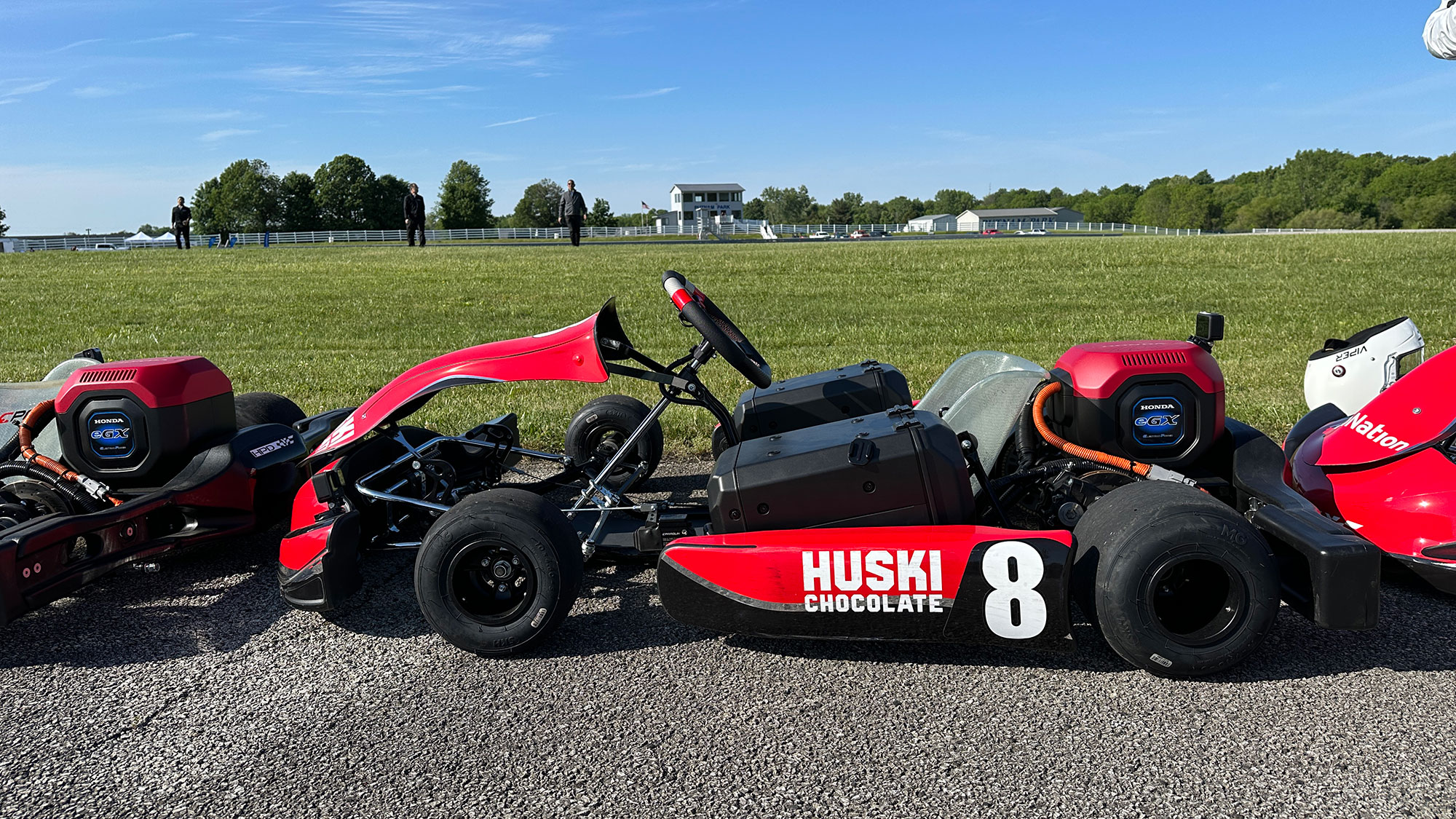

At first glance, race cars and electric go-karts have nothing in common except for a vaguely similar shape. Both are open-cockpit vehicles with wide wheels, and they both thrive on sharp turns—and that appears to be it.
What many don’t realize is that go-karts are often the entry point for future Indy 500 drivers, and competitors also practice in the tiny vehicles to develop muscle memory. Several companies manufacture karts, and the most recent iteration of Honda’s version is the eGX go-kart concept, which is equipped with two 10-kilo (about 23 pounds) swappable battery packs good for about 45 minutes at a time. This battery technology allows the brand to test the dynamics of electric vehicles on a smaller scale before rolling it out to the much pricier race cars (and eventually apply this insight to passenger vehicles as well).
Honda Accord, Civic, CR-V, and Odyssey owners might not realize it, but Honda’s passion starts with racing, and passenger cars reap the research benefits. Only two manufacturers make IndyCar engines, and Honda is one of them. In the last 30 years, Honda has claimed 18 IndyCar championships and 15 Indianapolis 500 wins.
PopSci had a chance to pilot one of these eGX karts in the Indianapolis area over Indy 500 weekend. It was heart-pounding, arm-muscle-straining excitement, like a taste of the race itself (minus the yellow and red flags). We also got to speak with engineers to better understand Honda’s strategy for its entire product lineup, from power tools to cars. Here’s what we learned.

Battery packs offer modularity and continuity
Kids interested in racing start with small go-karts and work their way up. If they have enough skill and a little luck, they’ll find themselves behind the wheel of a high-performance IndyCar or F1 machine. As they develop, drivers keep practicing with karts—albeit increasingly high-powered versions—that twist and squeal and mimic the experience of a road course race.
“Karts are closer to the open-wheel experience than anything else,” says John Whiteman, commercial motorsports manager at Honda Performance Development. (In case you were wondering, an open-wheel car is one that has its wheels outside of the car versus underneath, like a passenger car.)
Honda Performance Development, or HPD for short, was founded in 1993 for the purpose of designing and developing racing engines along with chassis and performance parts for motorsports. HPD has a history of repurposing small engines to make gas-powered karts and quarter midgets (small racers that are about one-quarter scale of a full-size midget race car).
If you’ve ever been to an outdoor recreational karting track with friends and family, you’re familiar with the whine and buzz of the gas-powered version. Gas-powered kart engines are often shared with lawn mowers, made by other companies like Briggs and Stratton as well as HPD, and indoor tracks use electric karts so they’re not filling the air with toxic fumes.
The eGX takes a typical electric go kart to the next level, employing two saddle packs on either side of the seat to house the lithium-ion batteries that power the kart. That way, the kart is balanced and maintains its grip with the road without adding rear bias or tip-over potential by loading the battery on one side.
Whiteman says the swappable battery packs offer many upsides, including reduced maintenance costs and environmental benefits. Through this technology, HPD has learned more about energy storage, heat management, and vehicle weights and balances. These battery packs are already in use for small construction equipment like cordless rammers and compact excavators.
Along with reduced emissions and noise pollution, battery-pack-powered vehicles keep the equipment in commission continuously if you have a bank of these batteries that can be charging up while the others are in use.
How race car research benefits Honda’s passenger cars
Ultimately, Honda and its HPD division are testing new ideas to find out how that translates to performance and customer satisfaction. Rebecca Johnson, HPD director of production and senior manager, says exploring electrification and sharing each division’s findings throughout the company creates opportunities to improve across the board.
“We’re trying to train ourselves to be better at hybrids and battery packs for electrified racing,” Johnson says. “Let’s build something. Let’s make a car and let’s call it our laboratory, if you will, and let people ‘play’ and iterate on the design or technology. As we strive forward, we can put that together with what customers want.”
In 2024, the IndyCar series will run with hybrid units with 2.2-liter engines; currently, the power is all supplied by renewable race fuel. Honda is getting ready for this change by testing battery packs and a custom concept hybrid built with a tubular cage and sheet metal copied from a production CR-V crossover. It’s mind-boggling to ride in the Beast, as Honda calls it internally, as it looks like an SUV with a giant wing and sounds like a screaming hurricane inside. This is the future, and it’s pretty exciting.
Johnson is steeped in racing culture, and she has her eyes trained forward as HPD works to maintain the visceral appeal of IndyCar and Formula One races while moving toward drastically reducing emissions.
“We’re a racing company that happens to sell cars,” Johnson says. “Racing is in our DNA. If we can prove out tough things on a race track, we can surely make a good Civic. If you can do it at [IndyCar] level, then you should be very good at performance for a Civic owner. They want all the things that we want [for race cars] but on a different level.”
